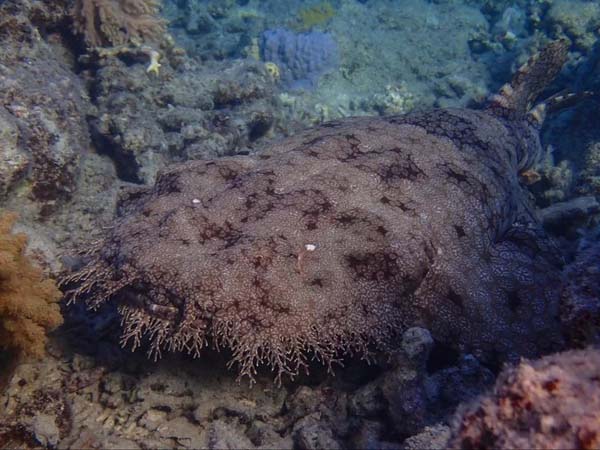Wobbegongs are members of the carpet shark family. They are called carpet sharks for the intricate patterns that cover the bodies of many members of this family. Here in the Whitsundays the most common species of wobbegong that you will encounter is the tasseled wobbegong. These guys have one of the most grumpy faces you will meet on the reef, if you can spot them. Wobbegongs are masters of disguise and the mottled patterns on their skin help them to blend in perfectly with the reef. They are also not considered to be aggressive towards humans unless they are provoked by people harassing them or attempting to take a tasty crayfish from under the sharks nose, in that case they may deliver a painful bite. They are also notorious for not wanting to let go so it is best to give them the space and respect that they deserve.
The tasseled wobbegong is native to the Indy-West Pacific and can be found in the warm tropical waters of northern Australia, New Guinea and surrounding islands. Its preferred habitat is shallow coral reefs however it can also be found in deeper offshore waters at depths of up to 50 meters. They are nocturnal bottom dwellers so during the day they can be found hiding in caves and under coral bombies and overhangs. At night they will venture out and actively forage and hunt for food.
Usually growing to a length of almost 2 meters the hassled wobbegong is classed as a medium sized shark. They also have a fringing beard of dermal lobes which run around the top jaw, these lobes are the reason for the name tasseled. Their colouring is mostly browns, creams and yellows with an ornate patterning of lines and spots. This helps them to blend in perfectly with the reef they rest on and the tassels further distort the shark's appearance making them excellent ambush predators. The teeth of these sharks are quite different from the typical serrated triangular shaped teeth which come to mind for most people when they think of sharks, they are long and thin like fangs, perfect for catching small fish.
While fish do make up a large part of the tasseled wobbegongs diet they will also feed on crustaceans like crayfish, octopuses and even on occasion smaller sharks. As mentioned above they are ambush predators. During the day they will sit in a cave or ideal spot on the reef blending in perfectly waiting for an unsuspecting fish to swim close enough to their mouth. Once the prey is within range the wobbegong will strike with lightning speed extending its jaws and sucking the animal in. They also have a little trick up their sleeve for bringing fish to them. They will wave their caudal fin (tail) around in a way that mimics the movement of a small fish, this lulu other small fish into a false sense of security and they approach thinking the area is safe.
Currently the tasseled wobbegong is listed as “least concern” by the IUCN. The reason for this is that it is of little commercial value so it is not targeted and exploited by any fisheries although they are sometimes harvested for their beautifully patterned skin which is turned into leather. However due to the human impacts and damage caused to the coral reefs these sharks rely on and call home they too are vulnerable to population declines. The fact that they have a relatively limited range adds to this vulnerability and as with all sharks in the ocean they are a vital part of the ecosystem so it is important that we took after them.

